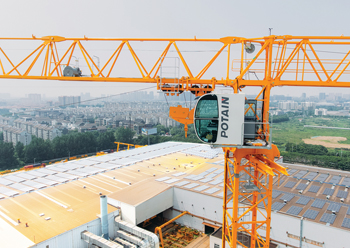Potain’s topless model holds wide appeal
01 October 2019
With the launch of the Potain MCT 325, Manitowoc has further expanded its popular MCT range of topless cranes.
The MCT 325 is designed to deliver easier transport and assembly, plus high efficiency and reliability on construction projects. It will ultimately replace the MC 310 model, a long-serving and popular hammerhead top-slewing crane with a proven history of customer satisfaction.
The crane is designed to support the increasing preference for precast concrete in construction.
The MCT 325 was unveiled in August during a special event at Manitowoc’s factory in Zhangjiagang, China, where the 16-tonne version was displayed with its full 75-m jib.
According to Potain tower cranes’ regional product manager Kwong-Joon Leong, the new model offers an efficient solution for customers requiring strong and versatile cranes in the 12- and 16-tonne classes.
“Topless cranes like the MCT 325 are becoming the go-to solution for projects utilising precast concrete, which is an increasingly popular choice for the speed and simplicity it brings to job sites,” he says.
“Topless cranes also bring speed and simplicity to projects, thanks to their design, which allows multiple units to overlap on site. The MCT 325 gives our customers a new choice in the 12- and 16-tonne range. And with its standout 75-m jib, we believe this new model will appeal to a wide range of companies and projects,” he adds.
The MCT 325 offers jib length configurations from 40 m up to an impressive 75 m, in increments of 5 m. At its 75-m jib end, the MCT 325 can handle 2.5 tonnes for the 12-tonne version and 2.3 tonnes for the 16-tonne version, making it one of the best-in-class performers for long-distance lifting.
Leong says the new model stays true to the design characteristics of Potain topless cranes, with easy transport and erection combined with excellent on-site performance.
“On a well-prepared site, the MCT 325 can be set up within 1.5 days, with the complete jib and counter-jib erected in four lifts,” he points out.
The MCT 325 is designed to work with the 2 m x 2 m L68 and L69 mast systems and can be utilised with fixing angles in a regular high-rise construction; in an internal climbing configuration; or mounted on a chassis, giving users maximum versatility.
- NFT boosts fleet to meet demand
- Terex’s new flat-top enhances versatility
- Zoomlion rough-terrain wins major order
- Comansa new model can take the load
- Raimondi luffing unit is a powerful performer
- Tadano acquires Demag Mobile Cranes
- Liebherr crawler eases geotechnical task
- Potain’s topless model holds wide appeal



